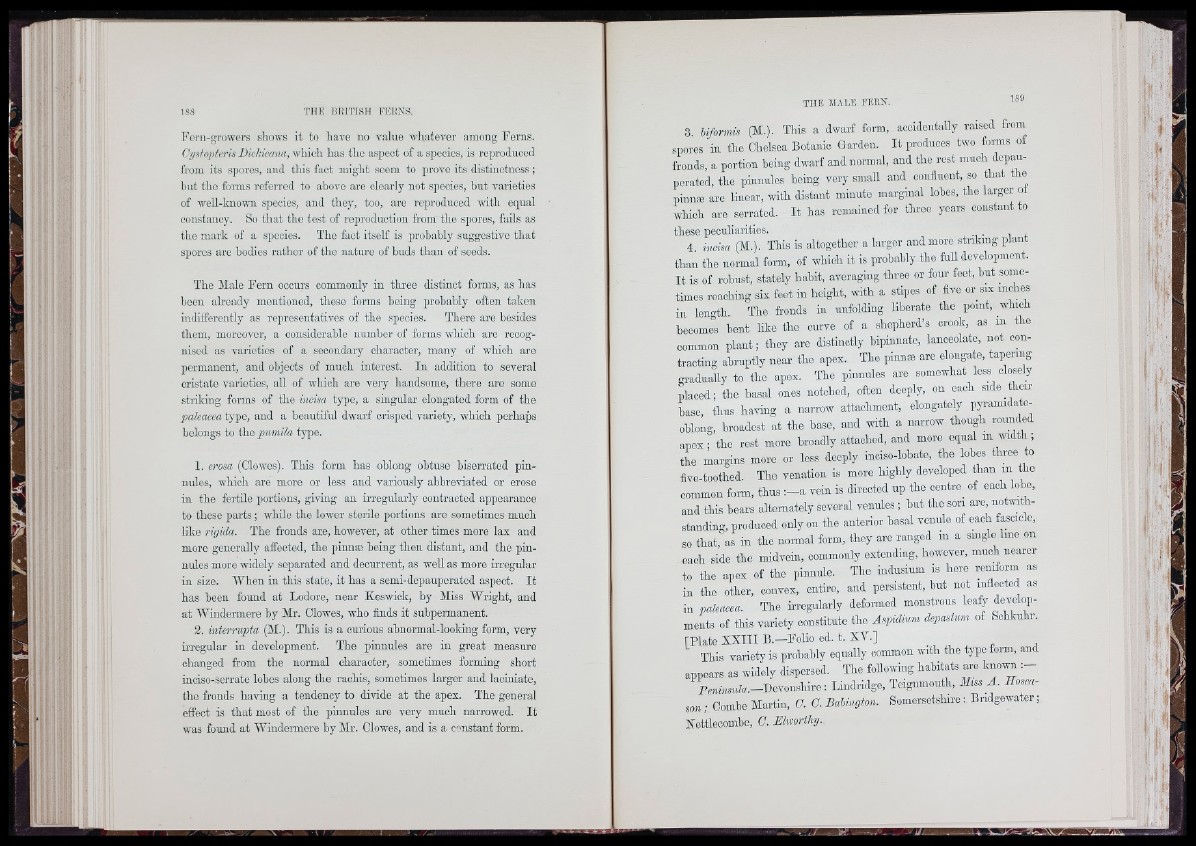
¡'’ei'n-gTowers shows it to havo no value whatever among Forns.
Cystopteris Dickicana, which has tho asjioct of a spccios, is reproduced
from its spores, and this fact might seem to prove its distiuctiioss ;
hut tho forms referred to above are clearly not species, but varieties
of well-kiiowu species, and tboy, too, aro reproduced with equal
constancy. So that tho test of reproduction from the spores, fails as
tho mark of a spccios. ïh o fact itself is probably suggestive th a t
spores are bodies rather of the nature of buds than of seeds.
The Male Fern ooours commonly in three distinct forms, as has
been already montiouod, these forms being probably often taken
indihbrcntly as representatives of the spccios. There arc besides
them, moreover, a considerable number of forms which aro recognised
as varieties of a secondary character, many of which are
permanent, and objects of much interest. In addition to several
cristate varieties, all of which are very handsome, there aro some
striking forms of the incisa typo, a singular elongated form of the
paleacea type, and a beautiful dwarf crisped variefy, which perhaps
belongs to the pumila type.
1. erosa (Clowes). This form has oblong obtuse biserrated pinnules,
which are more or less and variously abbreviated or orose
in the fertile portions, giving an irregularly contracted appearance
to these parts ; whilo tho lower sterile portions are sometimes much
like rigida. The fronds are, however, at other times more lax and
more generally affected, the pinnæ boing then distant, and the pinnules
more widely separated and decurrent, as well as more irregular
in size. "When in this state, it has a semi-depauperated aspect. I t
has been found at Lodore, near Keswick, by Miss Wright, and
a t lYindermere by Mr. Clowes, who finds it suhpermanent.
2. interrupta (M.). This is a curious ahnormal-looking form, very
irregular in development. The pinnules are in great measure
changed from the normal character, sometimes forming short
inciso-serrate lobes along the raohis, sometimes larger and laoiniate,
the fronds having a tendency to divide at the apex. The general
effect is that most of the pinnules are very much narrowed. I t
was found at IVindermore hy Mr. Clowes, and is a constant form.
3. Ufornrn (M.). This a dwarf form, accidentally raised from
spores in the Chelsea Botanic Garden. I t produces two forms of
fronds, a portion being dwarf and normal, and tho rest much depauperated,
the pinnules boing very small and confluent, so th a t the
pinnæ are linear, with distant minute marginal lobes, tho larger o
which are serrated. I t has remained for throe years constant to
these peouliaritios.
4. incisa (M.). This is altogether a larger and more striking plant
than the normal form, of which it is probably the M l development.
I t is of robust, stately habit, averaging three or four feet, hut sometimes
reaching six feet in height, with a stipes of five or six inches
in length. The fronds in unfolding liberate the point, which
becomes bent like tho curve of a shepherd’s crook, as in the
common plant ; they aro distinctly hipinnate, lanceolate, not contracting
abruptly near the apex. The pinnæ are elongate, tapering
gradually to tho apex. The pinnules are somewhat less closely
placed; the basal ones notched, often deeply, on each side their
base, thus having a narrow attachment, elongately pyramidate-
ohlong, broadest at the base, and with a narrow though rounded
apex; the rest more broadly attached, and more equal in width ;
the margins more or less deeply inciso-lohate, the lobes three to
five-toothed. The venation is more highly developed than in the
common form, thus ; - a vein is directed up the centre^ of each lobe,
and this hears alternately several venules ; but the son are, notwithstanding,
produced only on the anterior basal venule of each fascicle,
so that, as in the normal form, they are ranged in a single line on
each side the midvein, commonly extending, however, much nearer
to the apex of the pinnule. Tho indusium is here reniform as
in the other, convex, entire, and persistent, bnt not inflected, as
in paleacea. Tho hregularly deformed monstrous loafy
ments of this variety constitute tho Aspidium depastum of Schkuhr.
[Plate X X II I B.—Lolio od. t. XV.] . , „ «
This variety is probably equally common with the type form, and
appears as widely dispersed. The following habitats known
P®m'»8ttF.-Dovonshiro: Lindridge, Teignmouth, 3hss A . Iloseason
; Combe Martin, C. C. Babington. Somersetshire : Bridgewater ;
Nettlecombe, C. Elworthy.